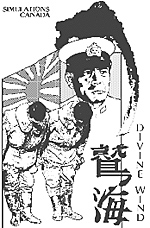
Players 2
Playing Long, but there are shorter scenarios time (one, two or three years)
Period WWII
Scale Strategic, sometimes operational Turn One month
Map 250 nautical miles each hexagon
Unit Naval divisions, infantry divisions, corps and armies, air fleets
Components
169 cm x 56cm Standard map
255 die-cut counters
1 half-size rule folder
1 Plastic box with counter tray on the bottom
Counter Manifest
91 Yellow Japanese counters
3 White Chinese counters
2 Pink Dutch counters
45 Red British counters
7 Green Australian counters
107 Blue US counters
SimCan says:
“The simulation is on the grand strategic level and thus has the players, representing the heads of the combined Japanese and Allies commands, making decisions as to where and when to strike and with how much force, rather than detailing the individual combat actions of fields commanders or individual units ... Divine Wind may be played in one, two, or three years scenarios starting from the beginning of the war or as a campaign game covering the entire war.”
The Reviewers say:
“All in all, Divine Wind is a remarkable technical design achievement. It is, however, too big for its format. The Pacific War buff will keep hoping for a game as perceptive and uncluttered as this, but with more realistic detail instead of ingenious but improbable design gimmicks.” --Friedrich Helfferich in F&M 32.
“Divine Wind is a good alternative to those who yearn after War in the Pacific but can’t afford to rent a hall. The bookkeeping makes it bad for solitaire, and the length puts it beyond the beer ‘n’ pretzels crowd.” --Nick Schuessler in Moves 59.
“Divine Wind ... suffers from a unique flaw; it’s too accurate for its own good. Simulating the entire Pacific theater calls for a broad concepts for the direction and fighting of that four-year campaign, which the designer handles well enough. But beyond that, Divine Wind attempts to balance a grand strategic focus with an operational accuracy, and still come out playable. For a Pacific war fan, interested in a detailed, logistically oriented game, Divine Wind offers a very involved system and guarantees many hours of enjoyment.” --James C. Gordon in The Grenadier 24.
Comments
Divine Wind has been well described by the different reviewers: a small jewel with too much inside. It is difficult to go into the game and play it correctly, but the result can be rewarding.
Collectors Notes
Perhaps not the best game on the subject but, for a collector of Pacific War Games, a must! Boone quotes low, high and average prices of 4/36/13.45 at auction and 11/30/18.29 for sale.
Errata
On the map hex 1014 is considered rough and hexes 1506 and 1822 are considered clear.
Steve Newberg says:
A very complex game in a small package. At the time I was unhappy with all of the treatments of the Pacific War except Victory in the Pacific, a fun game of ebb and flow, but having limited historical value. Divine Wind was the result. One map that came out very well, 255 counters that will still match the best made, and 16 pages of very dense rules lightened only by an evocative and very depressing MacGowan cover. People liked it. We got solid questions indicating serious play. It sold out its initial run and a reprint. And we are still making occasional attempts to produce something better on a computer. A good game, but a handful.
Back to Simulacrum Vol. 3 No. 2 Table of Contents
Back to Simulacrum List of Issues
Back to MagWeb Master Magazine List
© Copyright 2001 by Steambubble Graphics
This article appears in MagWeb (Magazine Web) on the Internet World Wide Web. Other military history articles and gaming articles are available at http://www.magweb.com